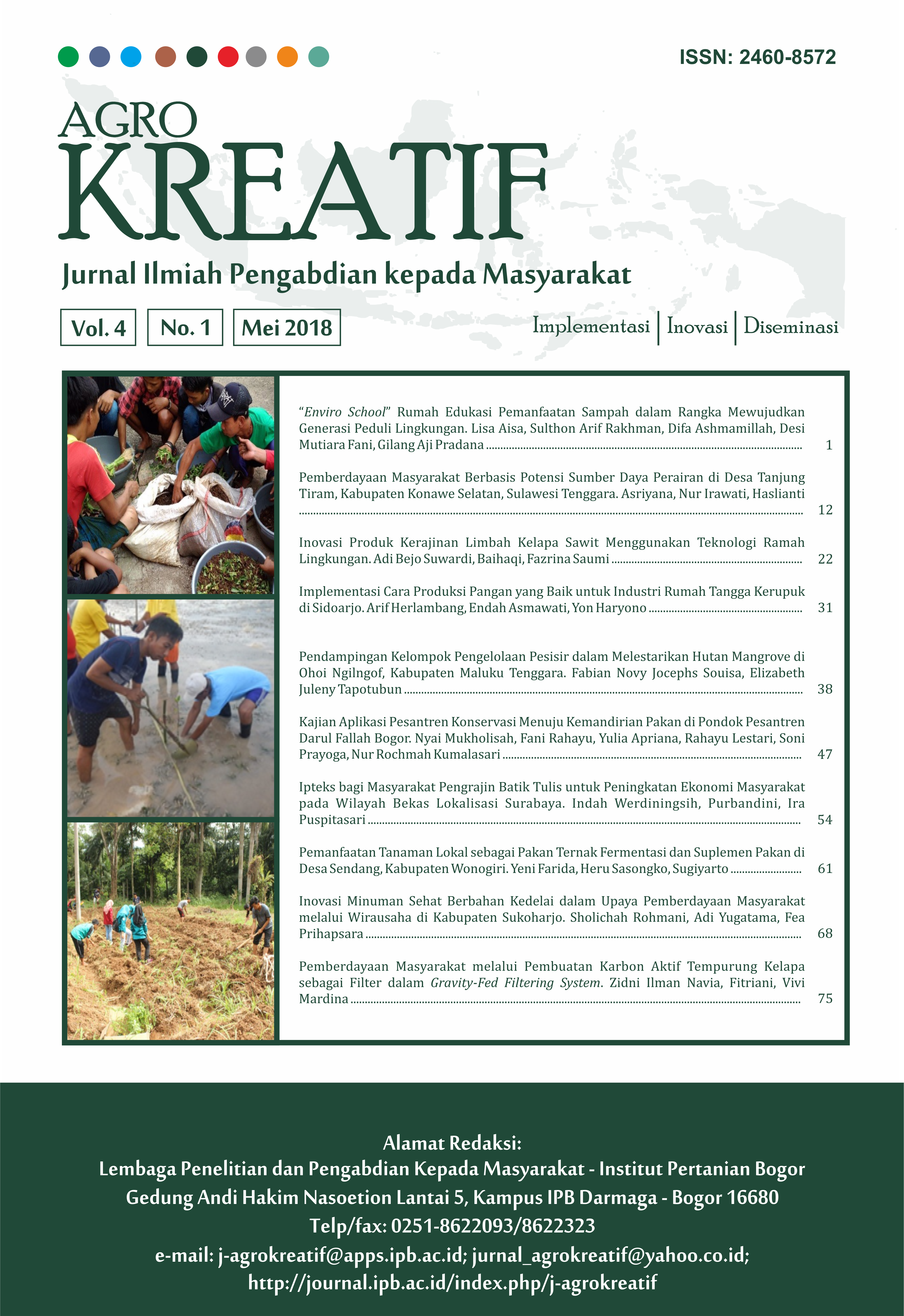Implementation of Good Food Production Method for Kerupuk Household Industry in Sidoarjo
Abstract
The owners of SME kerupuk Sidoarjo so far still glued to the traditional concept, that is only focus on the fulfillment of quantity, while the quality factor is still not the main focus. In order to compete in the era of free market, SME kerupuk Sidoarjo must give main focus on food quality. The focus of food quality improvement can be done through the fulfillment of food quality requirements by applying Good Food Production Methods for Household Industries (GFPM-HI). The implementation of GFPM-HI was conducted on two SMEs Sidoarjo, namely UD Dua Kelapa and Sinar Jaya. The process of applying GFPM-HI, starting from the process of identifying gender analysis pathway (gap), designing compliance requirements, implementation, and evaluation process. The evaluation results still have some criteria that have not been optimal. Overall, the process of applying CPPB-IRT UD Dua Kelapa and Sinar Jaya shows an increase in compliance scores of more than 40%.Downloads
References
Alegantina S, Isnawati A, Mutiatikum D. 2008. Sarana Produki Pada beberapa Pabrik Makanan dan Pengujian Mutu Makanan. Media Litbang Kesehatan. 18(4): 235–243.
[BPOM] Badan Pengawas Obat dan Makanan. 2003. Pedoman Cara Produksi Pangan yang Baik untuk Industri Rumah Tangga (CPPB-IRT). Keputusan kepala BPOM 00.05.5.1639.
Dinas Koperasi, Usaha Kecil dan Menengah Provinsi Jawa Timur. [Internet]. [Diakses 25 oktober 2017]. Tersedia pada: http://diskopukm.jatimprov.go.id/view-media.php?pages=content&id=57&bidang=.
Karipidis P, Athanassiadis K, Aggelopoulos S, Giompliakis E. 2009. Factors affecting the adoption of quality assurance systems in small food enterprises. Food Control. 20(2): 93–98. https://doi.org/10.1016/j.foodcont.2008.02.008
Muhandri T, Herawati D, Budi FS, Nuraida L, Koswara S, Agista AZ, Sukmawati Y. 2016. Kesiapan Usaha Mikro Kecil Menengah Pangan dalam Penerapan ISO 9001:2008 (Studi Kasus di Palu, Sulawesi Tengah). Agrokreatif Jurnal Ilmiah Pengabdian kepada Masyarakat. 2(2): 61–66. https://doi.org/ 10.29244/agrokreatif.2.2.61-66
Sunaru AC, Rahman A, Tantrika CFM. 2014. Analisa ketidaksesuaian persyaratan cara produksi pangan yang baik untuk industri rumah tangga (CPPB-IRT) untuk meminimasi kontaminasi produk roti. Jurnal Rekayasa dan Manajemen Sistem Industri. 2(2): 382–395.
Susetyo J, Simanjuntak RA, Ramos JM. 2010. Perancangan Ulang Tata Letak Fasiltas Produksi Dengan Pendekatan Group Tecnology dan Algoritma Blocplan untuk Meminimasi Ongkos Material Handling. Jurnal Teknologi. 3(1): 75–83.
Thaheer H. 2005. Sistem Manajemen HACCP (Hazard Analysis Critical Control Points). Jakarta (ID): Bumi Aksara.
Husaini U. 2008. Manajemen: Teori, Praktek, dan Riset Pendidikan. Jakarta (ID): Bumi Aksara.
Wahyuni T, Nurliza, Kurniati D. 2017. Preferensi konsumen terhadap pembelian kerupuk ikan di kota Sintang. Jurnal Social Economic of Agriculture. 6(1): 101–108. https://doi.org/ 10.26418/j.sea.v6i1.21592
Wignjosoebroto, Sritomo. (2003). Tata Letak Pabrik dan Pemindahan Bahan. Surabaya (ID): Guna Widya.
Yuwono B, Zakaria FR, Panjaitan NK. 2012. Faktor-faktor yang memengaruhi penerapan cara produksi yang baik dan standar prosedur operasi sanitasi pengolahan fillet ikan di Jawa. Manajemen IKM. 7(1): 10–19.
This work is licensed under a Creative Commons Attribution-NonCommercial 4.0 International License.



















